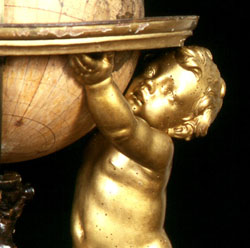 56. Terrestrial globe by G. and L. Valk
56. Terrestrial globe by G. and L. Valk
The globe’s stand consists of two gilded putti supporting the horizon, attributed to the sculptor Silvestro Giannotti (1680-1750) who, according to Luigi Crespi (op. cit.), is also the author of the fastigium over the large bookcase of the Geographical and Nautical Room, today kept in the Rector’s offices of the University. The compass attached to the stand is missing.
The title of the sphere is as follows:
Universi Orbis Terrarum facies
cum industria ac fide secundum certissimas et novissimas
Praestantissimorum Geographorum Observationes
denuo luci exposita cuique praeterea
Longitudinis ed Latitudinis gradus
Secundum Uranographiam novam,
ac proinde ex rei veritate, sunt iscripti per
Gerhardum et Leonhardum Valk,
Amstelaedami 1715.
cum Privilegio
Viro amplissima dignitate ac meritorum
splendore conspicuo JOHANNI TRIP.
J.U.D. Reipublicae Amstelaedamensis
Consuli gravissimo, Societatis Indiae
orientalis Moderatori integerrimo,
Toparchae in Berchenroden justissimo etc.
hanc universi ORBIS TERRARUM
faciem ea qua par est reverentia
D.D.D. Gerhardus et Leonhardus Valk.
L. Crespi (1769).
F. Farinelli (1979), p. 183.
M. Fiorini (1899), p. 388.